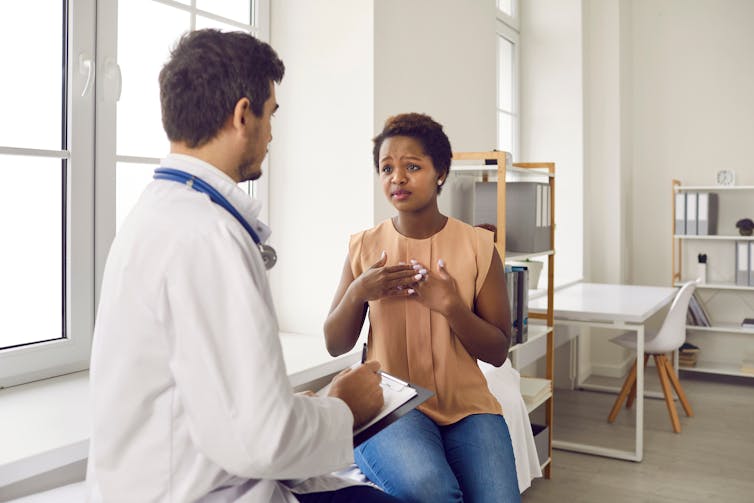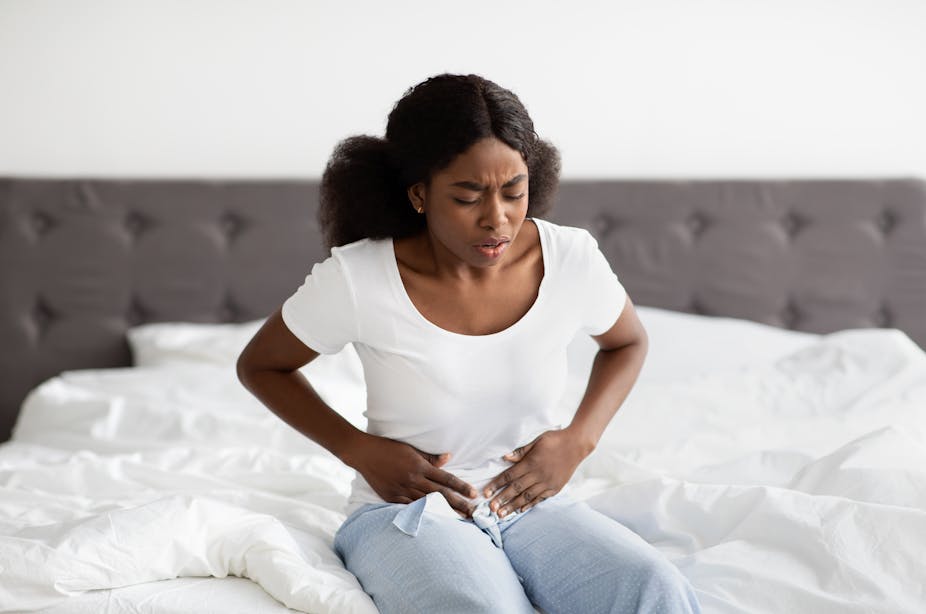Endometriosis is a common chronic inflammatory condition that affects an estimated one in ten people assigned female at birth. The condition causes tissue similar to the lining of the uterus to grow elsewhere – including on the ovaries, intestines, bladder and bowels. Symptoms can affect the whole body, but often include severe pelvic pain, painful periods, pain during sex, infertility and fatigue.
Sufferers of the condition wait between eight to 12 years on average for a diagnosis. Yet for black women, this picture is even worse – with research showing they’re 50% less likely to be diagnosed with endometriosis compared to white women.
There are a number of reasons for why this is the case – including barriers to gynaecological care and systemic racism in the medical field. But this means that black women may suffer for many more years as a result without a proper diagnosis or treatment.
Racial disparities
The poorer care that black women receive today for conditions such as endometriosis may actually be linked back to the very beginnings of the field of gynaecology, which has a legacy of racism and violent exploitation of black women’s bodies.
For example, J Marion Sims, the 19th-century American doctor who invented the speculum, performed numerous experimental surgeries without anaesthetics on enslaved women who could not consent throughout his career. The reason Sims chose not to use anaesthetic was, in part, because he believed black people had higher pain thresholds.
The legacy of this racist myth still persists today. In the US, one study found white medical students and doctors still believe that black patients are biologically less sensitive to pain compared to white patients. And, in the UK, a survey found that most black people have experienced prejudice from healthcare professionals when it came to care – including practitioners dismissing their pain.
These biases may partly explain why health professionals, in the US at least, are less likely to provide black women with pain medication during and after childbirth. Research has also shown that patients of colour consistently receive lower quality pain treatment for many different conditions.
Racial disparities in pain treatment are also found in endometriosis care. In the UK, women with endometriosis from minority ethnic groups are less likely to have their pain believed by clinicians. In the US, almost 72% of patients diagnosed with endometriosis are white and only around 5% are black. This discrepancy is staggering, especially considering there’s no definitive evidence endometriosis is more common in white patients.

The minority of black women who are diagnosed with endometriosis are diagnosed on average two and a half years later than white women. Black women are also less likely to receive endometriosis surgery – and if they do, are more likely to experience surgical complications afterwards.
The under-diagnosis of endometriosis in black patients was first identified in the 1970s. Despite this, we still have no reliable estimate of how common endometriosis actually is in black women. This is due to an absence of quality research and the persistent misconception that endometriosis is a “white career women’s disease” and is rare in patients of colour.
Need for change
This all not only means that black patients wait longer for endometriosis care – they’re less likely to receive care to begin with.
Undiagnosed endometriosis has potentially serious health consequences. Left untreated, endometriosis tissue may continue to grow, causing organ damage to the uterus, intestines, bladder and bowels. This can worsen already severe pelvic pain, and cause painful and extremely heavy periods, pain during sex, alongside bladder and bowel damage – which could lead to incontinence and bowel problems.
Endometriosis may also affect fertility. Almost half of all cases of infertility in women are potentially caused by endometriosis. Risks of pregnancy complications (including miscarriages) are also higher – particularly when it isn’t known that a patient has endometriosis.
Endometriosis also affects many aspects of a person’s life – from school attendance and achievements, to relationships, career performance and financial earnings. Without proper care, risks of anxiety, low-self esteem and depression are higher. In rare cases, the risk of self-harm and suicide are also higher for all those with endometriosis.
Much needs to change within the medical community to improve endometriosis and gynaecological care for black women. Mandatory training for health professionals on implicit racial bias, alongside dedicating funding to research investigating the prevalence and impact of endometriosis on black women are just a few of the things we recommend to make this happen. Another shortcoming in relation to black women’s endometriosis care is that the majority of available evidence comes out of the US. This further highlights the need for more research into this area to fully understand what the picture is in other parts of the world.
Black women who suspect they have endometriosis can find resources from organisations like Cysters, the Black Women’s Reproductive Health Project, EndoBlack and the Black Women’s Health Imperative.
Pain is not something you must suffer in silence. Keeping a diary of your pain and symptoms you may have as well as a list of questions when talking to your GP.

